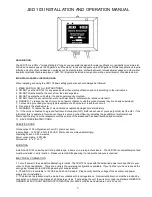
C2-1000 S
ERIES
O
PERATION
M
ANUAL
64
12.2
Edge-blending requirements
To obtain the best edge-blending results, you will need:
1. A perfectly flat projection screen. This is vital, or it will not be possible to
perfectly align your two projected images with each other.
2. Two matched projectors. Every projector on the market is different, with
different lenses, projection methods, brightness, contrast, etc. Ideally you will
need to identical projectors to obtain the best results.
3. A solid table or mounting bracket. Once you’ve set up your projectors and
aligned them, you will not want them to move – so some method of holding
them in place with brackets secured to walls or ceilings, or simply a sturdy
table, will be vital.
4. Adjustable mountings (or more preferably projectors with built-in advanced
adjustments). Proper alignment of two projectors can be very difficult, but will
be aided by using some sort of mounting bracket that is easily adjustable.
You may need to be able to move the projectors independently in all
directions: left, right, up, down, forward, backward and also be able to tilt them
to correct for any rotational errors.
5. Adjustable projectors. Most projectors will offer certain advanced features
such as key-stone correction. This will be vital to ensure proper alignment, as
it will partly compensate for mounting problems.
6. Of course, you’ll need one or more CORIO®2 units (depending on the model)
with the latest firmware that supports edge-blending.
S-curves for left and right projectors, with edges blended.
S-curves, when properly overlapping, will add together to result in full
brightness.
















































